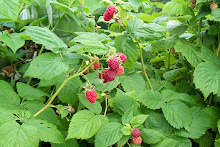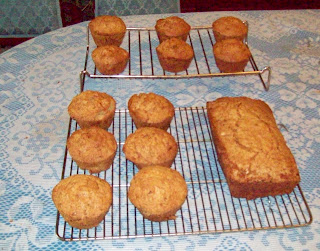Life doesn't always run smoothly and sometimes the results are tragic or annoying or really, really funny. Some you learn a lot from, others you re-learn something you had no business forgetting in the first place. This is one of the really funny ones with a dash of new knowledge tossed in to make the whole mis-adventure somewhat worthwhile.
I've always kept my worm bin in the cold room which also passes as the wood room come winter. It's a big room, we stack about 8 - 9 full wood cords in there every fall, and being over the uninsulated attached garage, it's cool in the summer and cold in the winter. Perfect place for the worms plus the bin is not in the house proper so that's a perk for the squeamish (not I of course; but there is a couple of people in the household who can't say "worms" without adding a "EEWWW").
Our wood order came and sat in our driveway. We have found that's the best way to get the wood in ASAP. We tend to do the chores first when they impede our convenience and comfort, not to mention being a constant reminder every time you open the door. Tripping over a log pretty much puts the thought "Oh geez, gotta get that wood in" right smack center front of the brain along with a bruise on your leg.
Putting the wood in is pretty efficient because we have a hole cut out in the garage floor and we simple toss the wood directly down into the wood room. Then we go down and stack. I say 'we', but easily 80% of the work is done by Don and the kids. I stay away mostly. 'We' can't very well throw the wood down if the worm bin is there because 'we' don't want logs bouncing off the bin. So 'we' moved the bin just outside the wood room where the washer is. I noticed that when the bin was moved, the tray and the four little cinder blocks that raises the bin over the tray did not get put back in place. I didn't really give it much thought, I figured it was only temporary and it wouldn't effect the worms. And it didn't, the worms did fine and the wood was being brought in over the next few days.
Then I noticed the worm bin had been put back into the wood room. It was still not raised over its tray but sitting directly on about 2 - 3 inches of bark that covered the floor. I kept intending to get the bin back on the tray but it was just not a priority since the worms seemed to be fine when I fed them. Though I must admit, in hindsight, I didn't see as many as usual when I checked the bin.
Last weekend, fate had it that Don and I were both in the wood room at the same time and it was the perfect time to address the worm bin. I had decided to move it out of the wood room because the wood room was getting a wee bit too chilly and I was worried the worms would freeze. So after setting up the tray and blocks in the new location, Don and I lifted up the bin. We were going to drag it because that's the way it had been moved but I thought lifting was a better idea just to make it easier on the worms. Sometimes my little voice is right on the money. We noticed right away a few worms wiggling in the bark. I picked them up and moved the bark around just in case the was a couple more...
"OH MY GOD!!!" Don exclaimed in shock and horror, "There's a whole HERD of them!" It didn't seem like a good time to point out that the proper word is 'squirm', I was a little taken back myself. Not to mention being very busy fervently thanking the powers that be we did decide to lift the bin and not drag it. I really wouldn't want to see the results of that - worm mush has no appealing ring to it at all. Turns out worms really like bark - something I didn't know. Since the worm bin was not suspended on blocks when a worm stuck its wee head out a ventilation hole in the bottom it didn't encounter wide open space. If it did, it would simply withdraw right back into the bin but since there was all the lovely, comfortable wood bark, the worms decided to pull up stakes and move to a better neighbourhood - the floor of our wood room.
The next half hour was spent with Don holding a spotlight while I picked up worms.
He: There's one.
Me: I see it.
He: Bunch over there.
Me: OK.
He: There's another freaking herd.
Me: Thanks, and they are called a squirm, horses are herds, worms are squirms.
HE: I don't care, let's just get 'em off the floor.
Must of picked up easily 500 worms. The good thing is, they didn't venture out past the area of the worm bin, must of been too cold once they were out from under the bin in the wide open space..."Wood Room Space, the final frontier, these are the voyages of the USS Worm Squirm..." You gotta be a Trekkie to appreciate that quote. Ah, adventures on the homestead. "What did you do all morning?" Answer in a long cowboy drawl. "We-elll, we's rounded up a maverick bunch of worms that broke loose from the squirm."
The adventure did have some benefits. The worms were healthy, very lively and squirmy, and a good color. They were obviously thriving in the bark and the one thing we have an abundance of is bark. I figure it'll make great bedding for them. Which is wonderful since their usual bedding, fallen leaves, is under a foot of snow. And, if there was any doubt left at all, you know you have found your one true love when spending half the morning picking up worms is full of giggles, puns and co-operation. Quality time shows up in the oddest and most unexpected places, just like worms.
Love Food, Not Waste - Dining Hall campaign
6 days ago
























 I found a recipe for zucchini bread. Again I adapted it a bit to our tastes. You can't even taste the zucchini in this. It's a tasty loaf with lemon and
I found a recipe for zucchini bread. Again I adapted it a bit to our tastes. You can't even taste the zucchini in this. It's a tasty loaf with lemon and 







